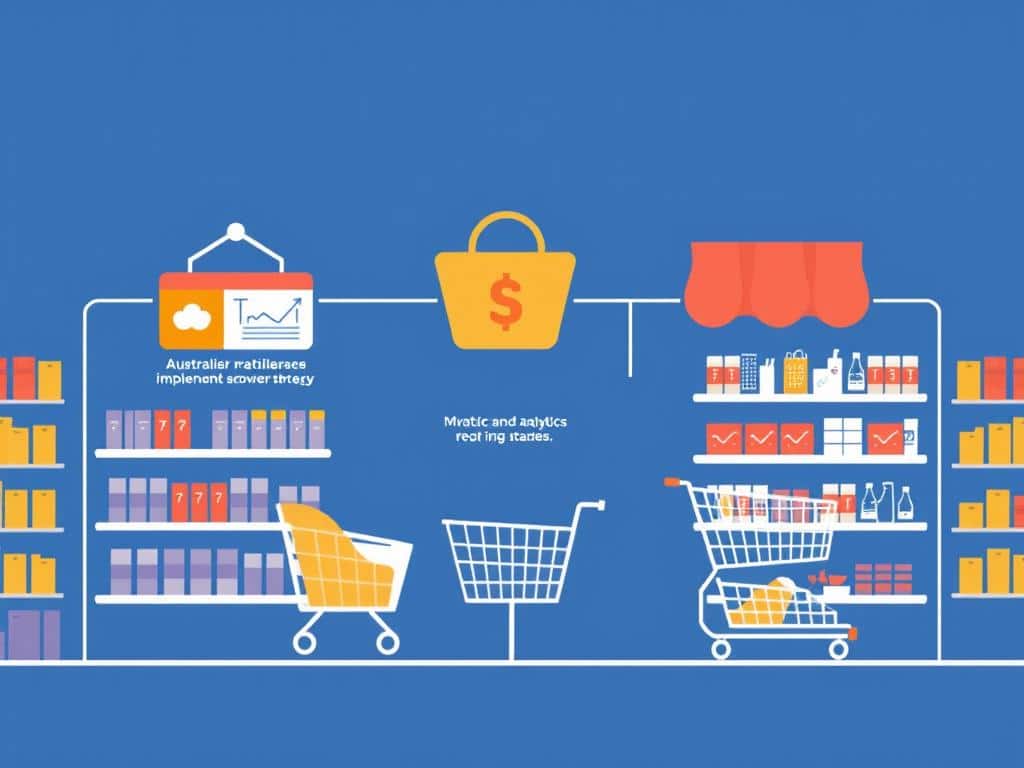In today’s fast-paced retail environment, the price you see for a product can change multiple times in a single day. This makes it challenging for consumers to know when they’re getting the best deal. Retailers are using sophisticated algorithms to adjust prices in real-time, responding to market conditions, competitor actions, and consumer behavior.
This strategy has revolutionized how retailers set their prices, moving away from fixed pricing models. With tools like Wispri, Australia’s leading price tracking platform, consumers can stay informed about price changes and make more informed purchasing decisions.
Key Takeaways
- Understand how dynamic pricing affects the products you buy.
- Learn strategies to navigate complex pricing environments.
- Discover tools that help you track price changes and save money.
- Make informed purchasing decisions with real-time price information.
- Stay ahead of retailers‘ pricing tactics.
What is Dynamic Pricing?
Dynamic pricing is revolutionizing the retail landscape in Australia. This strategy, also known as adaptive pricing, allows retailers to adjust prices in real-time based on various factors such as demand, competition, and customer demographics.
“The flexibility to change prices dynamically enables retailers to maximize profits during peak demand periods and remain competitive during slower periods,” said an industry expert. As a result, dynamic pricing has become a crucial tool for retailers looking to stay ahead in the market.
The Evolution of Retail Pricing
Traditionally, retailers used static pricing models, where prices remained fixed for extended periods. However, with the advent of digital technologies, dynamic pricing has become increasingly popular. This shift has been driven by the need for retailers to respond quickly to market changes and customer behavior.
Dynamic vs. Static Pricing Models
Static pricing offers simplicity and predictability, but often results in missed opportunities during high-demand periods. In contrast, dynamic pricing models allow retailers to capitalize on peak demand while still capturing sales during slower periods. For Australian consumers, understanding these models helps explain why prices for identical products can vary significantly across retailers.
How Dynamic Pricing Works in Retail
By harnessing the power of dynamic pricing, retailers can make informed decisions that drive sales and profitability. This approach to pricing involves the use of advanced technology and data analysis to adjust prices in real-time, responding to various market and customer factors.
The Technology Behind Price Fluctuations
The backbone of dynamic pricing is the sophisticated software that analyzes vast amounts of data to determine the optimal price for a product at any given time. This technology enables retailers to stay competitive by adjusting prices based on real-time market conditions, including demand, competitor pricing, and inventory levels.
Data Collection and Analysis in Pricing Decisions
Retailers collect enormous amounts of data to inform their pricing decisions, including historical sales data, real-time inventory levels, competitor pricing, and customer browsing patterns. Advanced analytics tools transform this raw data into actionable insights about price elasticity for specific products and customer segments.
The analysis extends beyond their own stores to include market-wide trends, economic indicators, and even social media sentiment analysis. Australian retailers, in particular, focus on analyzing seasonal patterns unique to the local market, such as holiday shopping behaviors and summer/winter transitions, to make data-backed pricing decisions.
Common Dynamic Pricing Strategies Retailers Use
Retailers leverage dynamic pricing strategies to influence consumer purchasing decisions. This approach allows them to adjust prices in real-time based on various factors, maximizing their revenue and staying competitive in the market.
Time-Based Pricing
Time-based pricing involves adjusting prices according to the time of day, week, or year. For instance, prices may be higher during peak hours or seasons and lower during off-peak times.
Competitor-Based Pricing
This strategy involves setting prices based on what competitors are charging. Retailers continuously monitor their competitors’ prices and adjust their own accordingly to remain competitive.
Demand-Based Pricing
Demand-based pricing is a strategy where prices are adjusted according to demand. When demand is high, prices are increased, and when demand is low, prices are decreased.
Segmented Pricing
Segmented pricing involves charging different prices to different customer segments. This could be based on demographic factors, purchase history, or other criteria.
Value-Based Pricing
Value-based pricing sets prices according to the perceived value to customers rather than based on costs or competitor prices. This approach is common among premium retailers who emphasize quality and exclusivity.
| Pricing Strategy | Description | Example |
|---|---|---|
| Time-Based Pricing | Prices adjusted based on time | Higher prices during peak hours |
| Competitor-Based Pricing | Prices set based on competitors | Matching a competitor’s sale price |
| Demand-Based Pricing | Prices adjusted according to demand | Increasing prices during high demand |
Understanding these dynamic pricing strategies helps consumers make informed purchasing decisions and retailers to optimize their pricing approaches.
Price Skimming and Penetration Pricing
Retailers often employ two contrasting pricing strategies to maximize their market share and revenue: price skimming and penetration pricing. These strategies are crucial in determining how a product is perceived by consumers and how it competes in the market.
How Price Skimming Works
Price skimming involves setting a high initial price for a product to maximize profits, particularly when the product is new or innovative. This strategy is often used for technology products or luxury goods where early adopters are willing to pay a premium. The price is gradually lowered over time to attract more price-sensitive customers.
When Retailers Use Penetration Pricing
Penetration pricing is almost the opposite of price skimming. With this strategy, you set prices low during your launch in order to attract customers and pull people away from your competition. Once you’ve built up a strong customer base and proven the worth of your product or service, you can gradually increase the price of your product.
Some key aspects of penetration pricing include:
- Setting initially low prices to rapidly gain market share and customer adoption.
- Gradually increasing prices once a customer base is established.
- Australian retailers typically employ this strategy when entering markets with strong existing competition.
| Pricing Strategy | Initial Price | Price Over Time | Target Market |
|---|---|---|---|
| Price Skimming | High | Decreases | Early adopters, luxury consumers |
| Penetration Pricing | Low | Increases | Price-sensitive customers, competitive markets |

Major Australian Retailers Using Dynamic Pricing

Dynamic pricing has become a staple in the Australian retail landscape, with major players adopting this strategy to stay competitive. This pricing strategy allows retailers to adjust prices in real-time based on various factors such as demand, competition, and customer behavior.
Online vs. Brick-and-Mortar Implementation
The implementation of dynamic pricing varies significantly between online and brick-and-mortar retailers. Online retailers like Amazon Australia can adjust prices multiple times a day, leveraging advanced algorithms and vast data resources. In contrast, physical stores face challenges such as updating price tags and training staff, making their dynamic pricing strategies less frequent and complex.
Case Studies: Amazon Australia and Other Major Players
Amazon Australia stands out as a sophisticated practitioner of dynamic pricing, utilizing its global expertise to adjust prices based on competitor pricing, inventory levels, and individual browsing patterns. Other major Australian retailers, including JB Hi-Fi, Harvey Norman, Officeworks, and Bunnings, have also adopted dynamic pricing strategies tailored to their business models. eBay Australia presents a unique case, operating both as a marketplace and a dynamic pricing environment.
These case studies demonstrate how different retailers adapt dynamic pricing to their specific business models, market positions, and customer expectations, showcasing the versatility and potential of this pricing strategy in the Australian retail market.
The Benefits of Dynamic Pricing for Retailers
The flexibility of dynamic pricing allows Australian retailers to maximize their revenue and respond effectively to market fluctuations. This approach enables businesses to adjust their pricing strategy in real-time, ensuring they remain competitive in a dynamic market.
Maximizing Revenue and Profit Margins
Dynamic pricing helps retailers optimize their pricing to maximize revenue and profit margins. By analyzing market conditions, competition, and consumer demand, businesses can set prices that balance profitability with customer affordability. For instance, during peak demand periods, retailers can increase prices to capitalize on the higher demand, thereby maximizing revenue.
Responding to Market Changes in Real-Time
One of the key benefits of dynamic pricing is the ability to respond to market changes in real-time. Retailers can quickly adjust prices in response to changes in market conditions, competitor actions, or supply chain disruptions. This agility is particularly valuable in volatile markets or during unexpected events, where consumer demand patterns can shift rapidly.
| Benefits | Description |
|---|---|
| Real-time Responsiveness | Enables retailers to respond immediately to changing market conditions and competitor actions. |
| Revenue Maximization | Helps retailers optimize prices to maximize revenue during peak demand periods. |
| Competitive Advantage | Provides a significant competitive edge over retailers using traditional fixed pricing models. |
By adopting dynamic pricing, Australian retailers can enhance their business strategy and improve their competitiveness in the market. The ability to adjust prices in real-time allows retailers to stay ahead of the competition and capitalize on emerging trends.
The Consumer Impact of Dynamic Pricing
The impact of dynamic pricing on consumers is a complex issue that involves various psychological and economic factors. As retailers increasingly use dynamic pricing strategies, it’s essential to understand how these affect consumer behavior and purchasing decisions.

Effects on Shopping Decisions
Dynamic pricing can significantly influence shopping decisions, often in subtle ways. Australian consumers, for instance, use reference prices to evaluate whether current prices represent good value. When dynamic pricing disrupts these reference points, it can make determining a “fair” price challenging.
- Consumers may feel uncertain about the value they’re getting.
- The frequency of sales and discounts can lead to skepticism about standard pricing.
The Psychology Behind Price Perception
Price perception is highly subjective and influenced by numerous psychological factors beyond the actual dollar amount. Value-based pricing, for example, involves setting prices according to customer perceptions, not costs. This strategy can result in higher prices for luxury brands due to their perceived value.
| Pricing Strategy | Consumer Perception | Impact on Sales |
|---|---|---|
| Value-Based Pricing | High-end or luxury perception | Increased sales for premium products |
| Dynamic Pricing | Variable prices based on demand | Potential for increased revenue |
Transparency about pricing practices can significantly impact consumer trust. When consumers understand the rationale behind price variations, they are more likely to accept them.
How to Spot Dynamic Pricing as a Consumer
With dynamic pricing becoming increasingly prevalent, consumers need to be vigilant about price changes. As retailers employ sophisticated pricing strategies, it’s essential to understand how to identify potential price manipulation.
Common Signs of Price Manipulation
One of the primary indicators of dynamic pricing is frequent price fluctuations. If you notice that the price of a product changes frequently within a short period, it may be an example of dynamic pricing in action. Additionally, be wary of prices that seem to be adjusted based on your browsing history or location.
Tools to Track Price Changes
Fortunately, several tools are available to help consumers track prices and identify the best time to make purchases. Browser extensions like Honey and Camelizer can display price history graphs and alert you to price drops while shopping online. For a more comprehensive solution, dedicated price tracking services like Wispri utilize advanced software to monitor prices across multiple retailers and provide customizable price drop alerts.
| Tool | Functionality | Benefit |
|---|---|---|
| Honey | Price history graphs, price drop alerts | Helps consumers identify genuine sales |
| Camelizer | Price history graphs, price drop alerts | Alerts users to price drops while shopping online |
| Wispri | Advanced price monitoring, customizable alerts | Provides comprehensive price tracking across multiple retailers |
Introducing Wispri: Australia’s Leading Price Tracking Platform
![]()
For consumers tired of dynamic pricing, Wispri offers a beacon of hope with its advanced price tracking technology. Wispri comprehensively covers Australia’s major retail landscape, tracking prices across dozens of popular stores where dynamic pricing is common.
Key Features and Benefits
Wispri’s platform is designed to help consumers make informed purchasing decisions. The key benefits include:
- Comprehensive coverage of major Australian retailers
- Real-time price tracking and alerts
- Historical price data analysis
Retailers Covered by Wispri
Wispri monitors prices from major Australian retailers, including:
- Amazon Australia and eBay
- Electronics retailers like JB Hi-Fi, Harvey Norman, The Good Guys, and Bing Lee
- Home improvement and office supply retailers like Bunnings and Officeworks
The platform continuously expands its retailer coverage based on user feedback and market trends, ensuring comprehensive tracking across the Australian retail ecosystem.
How to Use Price Tracking to Beat Dynamic Pricing
To outsmart dynamic pricing, it’s essential to understand how to effectively use price tracking tools. By doing so, you can make informed purchasing decisions and avoid overpaying for products.
Setting Up Price Alerts Effectively
One of the key features of price tracking is setting up price alerts. This allows you to receive notifications when the price of a product you’re interested in drops. To set up price alerts effectively, identify the products you want to track and set the alert thresholds accordingly.
Interpreting Historical Price Data
Historical price data provides valuable insights into a product’s pricing trends. By analyzing this data, you can identify patterns such as regular sales cycles, seasonal discounts, or price drops before new model releases.
| Price Tracking Feature | Description | Benefit |
|---|---|---|
| Price Alerts | Receive notifications when prices drop | Stay informed about price changes |
| Historical Data Analysis | Analyze past price trends | Make informed purchasing decisions |
| Comparative Analysis | Compare prices across retailers | Find the best deals on products |
By leveraging these features and understanding how to interpret price information, you can beat dynamic pricing and save money on your purchases. Wispri’s price tracking platform provides the necessary data to make informed decisions.

Ethical Considerations in Dynamic Pricing
Dynamic pricing, while legal in Australia, poses significant ethical challenges for retailers and consumers alike. The practice, though subject to broader consumer protection laws, raises concerns about fairness and transparency.
Consumer Rights and Transparency
Consumers have the right to be informed about pricing practices. Retailers must ensure that their dynamic pricing strategies are transparent, avoiding misleading or deceptive practices.
Regulatory Landscape in Australia
Australian regulations prohibit price collusion and misleading pricing practices. The regulatory landscape continues to evolve as dynamic pricing becomes more sophisticated.
| Regulatory Aspect | Description | Impact on Business |
|---|---|---|
| Consumer Protection Laws | Administered by the ACCC, these laws protect consumers from misleading practices. | Businesses must comply with these laws to avoid penalties. |
| Price Collusion | Collusion between competitors to fix prices is illegal. | Companies must ensure their dynamic pricing algorithms do not facilitate collusion. |
| Transparency | Retailers must be transparent about their pricing practices. | Transparency builds consumer trust and loyalty. |
Conclusion: Navigating the Dynamic Pricing Landscape
The Australian retail scene has undergone a substantial transformation with the advent of dynamic pricing, presenting both challenges and opportunities for consumers. Understanding the mechanisms behind these pricing strategies empowers shoppers to make more informed decisions and potentially save significant money on their purchases. Tools like Wispri provide Australian consumers with the information needed to navigate this complex pricing environment effectively. By tracking prices and timing purchases strategically, savvy consumers can use dynamic pricing to their advantage.
FAQ
What is the main goal of using a value-based pricing strategy?
The primary objective of a value-based pricing method is to set prices according to the perceived value of a product or service to customers, thereby maximising revenue and profit margins.
How do retailers use price skimming to influence sales?
Retailers use price skimming by initially setting high prices for new or innovative products to capture maximum revenue from customers willing to pay a premium, before gradually reducing prices as the market becomes more competitive.
What is the difference between penetration pricing and other pricing methods?
Penetration pricing involves setting low initial prices to quickly gain market share, whereas other pricing strategies, such as price skimming, focus on maximising initial revenue by setting higher prices.
How do market conditions affect a retailer’s pricing decisions?
Market conditions, including competition, demand, and consumer behaviour, significantly influence a retailer’s pricing decisions, as they need to adjust their pricing strategies to remain competitive and responsive to changing market dynamics.
What role does data collection and analysis play in pricing decisions?
Data collection and analysis are crucial in informing pricing decisions, as they enable retailers to understand consumer behaviour, track market trends, and adjust their pricing strategies accordingly to maximise revenue and stay competitive.
How can consumers use price tracking to make informed purchasing decisions?
Consumers can utilise price tracking tools to monitor price changes, identify trends, and make informed purchasing decisions by buying products when they are at their cheapest, thereby saving money and beating dynamic pricing strategies.
What are the benefits of using a pricing model that adjusts to market changes?
The benefits of using a pricing model that adjusts to market changes include maximising revenue, staying competitive, and responding effectively to shifts in demand and consumer behaviour.
How do retailers implement segmented pricing to target different customer groups?
Retailers implement segmented pricing by offering different prices for the same product or service to various customer segments based on their willingness to pay, demographics, or other factors, thereby maximising revenue from each segment.

